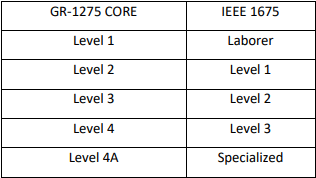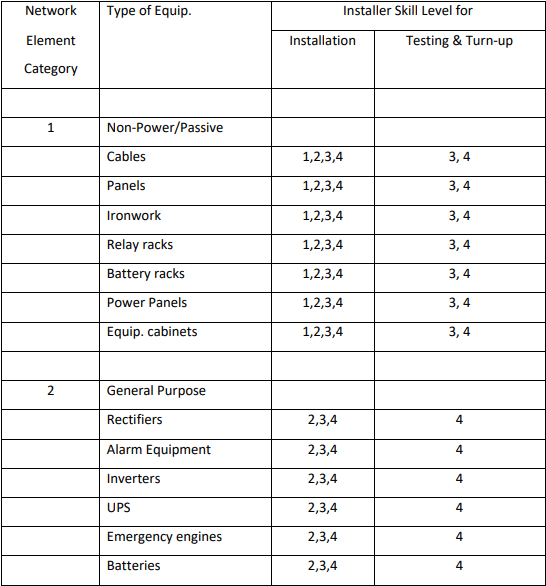For many years, the only training guide for technician skill levels had emerged from the American Telephone and Telegraph Company (AT&T). After the breakup of the AT&T monopoly in 1983, it was promulgated by the regional Bell Operating Companies (RBOC’s) under the wings of their newly established subsidiary, Bell Communications Research, Inc, known as Bellcore.
Bellcore was taken over by Telcordia, which was owned by SAIC and is now owned by Eriksson, who have retained the Telcordia name. The document referred to above is Generic Requirement (GR) 1275 – CORE, Central Office Environment Installation/Removal Generic Requirements. This document outlined and detailed the skill levels that were required by technicians performing various tasks when working on telecommunications power equipment. This document was relatively unknown outside of the telecommunications industry.
GR-1275-CORE has four levels of Field Service and Installation Technicians. Many of the tasks contained within refer to work not directly associated with batteries. In light of this, in the early 2000’s, the Institute of Electrical and Electronic Engineers (IEEE) Stationary Battery Committee (SBC) decided that a standard should be written that solely focused on stationary batteries. This was to become known as IEEE Standard 1657, IEEE Recommended Practice for Personnel Qualification for Installation and Maintenance of Stationary Batteries. This also details four skill levels but differs somewhat from GR1275-CORE as it focuses only on battery work.
In other words, while GR-1275-CORE focuses on power equipment installation and removal, IEEE Std. 1657 focuses only battery installation and maintenance. The purpose of the document is to be a guide for the levels of skill and knowledge required; it is not intended to be a tutorial approach.
The different level designations are shown in the table below:

Telcordia Technologies GR-1275-CORE Skill Levels.
Skill Level 1 Summary
Installers at Skill Level 1 shall:
- Be directly supervised and instructed by a Skill Level 3 or 4 installer or the job supervisor.
- Be capable of performing the following work operations/job activities:
- addition or removal of Common Systems equipment/hardware.
- Not perform Skill Level 2 and above work operations/job activities unless properly supervised.
- Not progress to Skill Level 2 without a minimum of 1-1/2 years of experience or Equivalent, as determined by the Installation Supplier’s training process, and demonstrated to the Telecommunications Carrier’s (TC) Representative upon request, proficiency in the system/environment (e.g., Common Systems) being worked on, or hold a certificate of completion from a training facility providing an appropriate curriculum.
- Not perform work operations/job activities on working equipment or circuits.
Skill Level 2
Installers at Skill Level 2 shall:
- Have a minimum of 1-1/2 years of experience, or equivalent, as determined by the Installation Supplier’s training process and demonstrated to the TC Representative upon request, proficiency in the system/environment (Network elements 1, 2, or 3) being worked on, or hold a certificate of completion from a training facility providing an appropriate curriculum.
- Be directly supervised and instructed by a Skill Level 3 or 4 installer or the job supervisor.
- Be capable of performing the following work operations/job activities:
- addition or removal of Common Systems equipment hardware.
- addition or removal of wiring and connections (on non-working equipment only and switchboard cable only).
- lead verification/continuity testing.
- Not perform Skill Level 3 or 4 work operations/job activities unless properly supervised.
- Not progress to Skill Level 3 without a minimum of 3 years accumulated experience or equivalent as determined by the Installation Supplier training process.
- . Not perform work operations/job activities on working equipment or circuits unless directly supervised. Refer to Table 23-1.
Extract from Table 23.1

Skill Level 3
Installers at Skill Level 3 shall:
- Have a minimum of 3 years of accumulated experience, or equivalent, as determined by the Installation Supplier’s training process and demonstrated to the TC Representative upon request, proficiency in the system (Network elements 1, 2, 3, or 4) being worked on, or hold a certificate of completion from a training facility providing an appropriate curriculum.
- Be capable of performing the following work operations or job activities without supervision or direction:
- addition or removal of Common Systems equipment hardware
- addition or removal of wiring and connections (on non-working equipment only)
- lead verification/continuity testing
- analysis of job specifications and drawings
- provide work assignments to Skill Level 1 and 2 installers
- prepare a Method of Procedure (MOP)
- write Job Information Memos (JIM)
- resolve job specification and/or drawing problems
- mark/correct office record drawings
- in-process and final quality inspections
- Be capable of performing as the Installation Supplier’s in-charge person on Common Systems jobs.
- Not perform Skill Level 4 work operations/job activities unless properly supervised.
- Not progress to Skill Level 4 without a minimum of 6 years of accumulated experience or equivalent as determined by the Installation Supplier’s training process.
- Not perform work operations/job activities on working equipment or circuits unless directly supervised. Refer to Table 23-1.
Skill Level 4
Installers at Skill Level 4 shall:
- Have a minimum of 6 years accumulated experience or equivalent as determined by the Installation Supplier’s training process and demonstrated to the TC Representative upon request, proficiency in the system (Network elements 1 and 2) being worked on, or hold a certificate of completion from a training facility providing an appropriate curriculum.
- Be capable of performing the same work operations/job activities as a Skill Level 3 installer without supervision or direction.
- Be capable of performing as the Installation Supplier’s in-charge person.
- Be capable of performing additions, removals, and modifications on working equipment and circuits. Skill Level 4 work operations/job activities may include:
- circuit modifications
- software additions or upgrades
- power transition work
- addition or removal of batteries.
- Addition or removal of circuits on working power distribution sources.
- Equipment testing and turn-up.
Skill Level (4A)
A Skill Level 4A person shall be technically competent and have successfully completed training in the Test and Turn-Up procedures for a specific piece of equipment or procedure. This person shall not be considered able to perform all the work operations of the Skill Level 1 through 4 installer.
IEEE Standard 1657 Technician Skill Levels.
Laborer
In some cases, laborers are called in to help with battery work. They must have at least some rudimentary battery safety training before they begin working on or near batteries. Items they should know are identified in the text by an “(L0)” designation. Laborers always require supervision by a Level 2 or higher technician.
Level 1
Level 1 battery technicians should know basic safety and additional core skills. Items they should know are identified in the text by an “(L1)” designation. They also need to be trained on all of the laborer (L0) items. Level 1 technicians often require higher level supervision for specific tasks.
Level 2
Level 2 battery technicians should know battery basics, including the basics of maintenance and installation. Level 2 technicians should have on-the-job training (OJT) as a Level 1 (generally at least 6 months) or previous experience (verified by observation by a Level 3 technician or qualified instructor) before becoming a Level 2. Items that a Level 2 technician should know are denoted in the text by an “(L2)” designation. Level 2 technicians sometimes require higher level supervision for specific tasks.
Level 3
Level 3 battery technicians should be able to perform work independently, except for areas requiring specialized knowledge. Level 3 technicians should generally have at least one year of OJT as a Level 2 or previous equivalent experience (verified by observation by an experienced Level 3 technician or qualified instructor) before becoming a Level 3. Items that a Level 3 technician should know are denoted in the text by an “(L3)” designation
Specialized knowledge
Items in the text that are application specific are denoted by an “SK” designation. The instructor can pick and choose which, if any, of these subjects are covered in the curriculum, depending on the needs of the audience.
Summary
As can be seen, there are some significant differences between the two documents. It is generally accepted that personnel working on stationary batteries should adhere to IEEE-1675. However, if the work involves telecommunication batteries and associated equipment, GR-1275 should be considered.
Need a Copy of What You Just Read?
Download the PDF version of this white paper for future reference.
